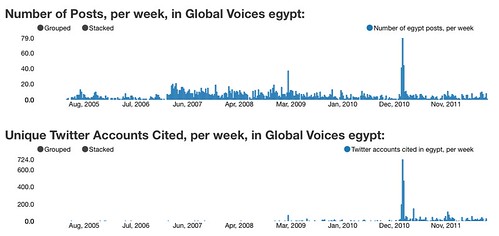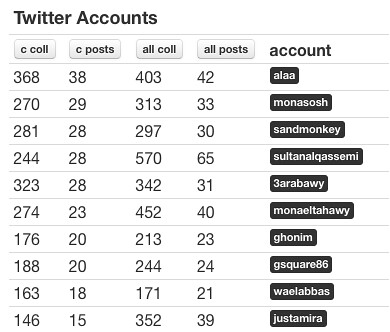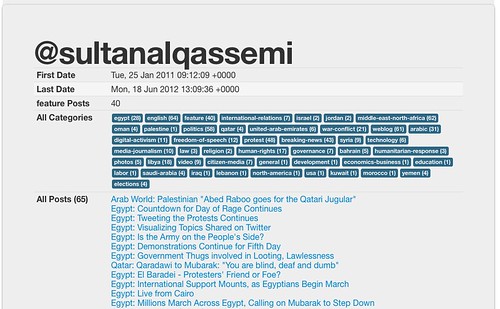Citizen journalism and social media have become major sources for the news, especially after the Arab uprisings of early 2011. From Al Jazeera Stream and the NPR’s Andy Carvin to the Guardian’s Three Pigs advert, news organisations recognise that journalism is just one part of a broader ecosystem of online conversation. At the most basic level, journalists are following social media for breaking news and citizen perspectives. As a result, designers are rushing to build systems like Ushahidi’s SwiftRiver, to filter and verify citizen media.
Audience analytics and source verification only paint part of the picture. While upcoming technologies will help newsrooms understand their readers and better use citizen sources, we remain blind to the way the news is used in turn by citizen sources to gain credibility and spread ideas. That’s a loss for two reasons. Firstly, it opens newsrooms up to embarrassing forms of media manipulation. Most importantly, we’re analytically blind to one of bloggers’ and citizen journalists’ greatest incentives: attention.
For my Media Lab Master’s Thesis, I’m trying to re-imagine how we think about media representation in online media ecosystems. Over the next year, my main focus will be gender in the media. But this summer, for a talk at the Global Voices Summit in Nairobi, I developed a visualization of media representation in Global Voices, who have been reporting on citizen media far longer than most news organisations.
I’m hoping the following analysis of Global Voices convinces you that tracking media representation is exciting and important. If your news organisation is interested in developing these kinds of metrics, or if you’re a Global Voices editor trying to understand whose voices you amplify, I would love to hear from you. Contact me on Twitter at @natematias or at natematias@gmail.com.
Media Representation in Global Voices Egypt and Libya
My starting questions were simple: whose voices (from Twitter) were most cited in Global Voices coverage of the Arab uprisings, and how diverse were those voices? Was Global Voices just amplifying the ideas of a few people, or were they including a broad range of perspectives? Global Voices was generous enough to share its entire English archive going back to 2004, and I built a data visualisation tool for exploring those questions across time and sections:
- Global Voices Twitter Citation Visualisation (best with Firefox)
- Watch the Tutorial Video (9 minutes)
Let’s start with Egypt (click to load the Egypt visualisation). Global Voices has been covering Egypt since its early days. The first major spike in coverage occurred in Feb 2007 when the blogger Kareem Amer was sentenced to prison for things he said on his blog. The next spike in coverage, in Feb 2009, occurred in response to the Cairo bombing. The largest spike in Egypt coverage starts at the end of Jan 2011 in response to protests in Tahrir Square and is sustained over the next few weeks. Notice that while Global Voices did quote twitter from time to time (citing 68 unique Twitter accounts the week of the Cairo bombing), the diversity of Twitter citation grew dramatically during the Egyptian uprising — and actually remained consistently higher thereafter.
Why was Global Voices citing Twitter? By sorting articles by Twitter citation in my visualisation, it’s possible to look at the posts which cite the greatest number of unique Twitter accounts. Some posts reported breaking news from Tahrir, quoting sources from Twitter. Others report on viral political hashtag jokes, a popular format for Global Voices posts. Not all posts cite Egyptian sources. This post on the global response to Egyptian uprising shares tweets from around the world.
By tracking twitter citation in Global Voices, we’re also able to ask: whose voices was GlobalVoices amplifying? Citation in blogs and the news can give a source exposure, credibility, and a growing audience.
In the Egypt section, the most cited Twitter source was Alaa Abd El Fattah, an Egyptian blogger, software developer, and activist. One of the last times he was cited in Global voices was in reference to his month long imprisonment in November 2011.
Although Alaa is prominent, Global Voices relied on hundreds of other sources. The Egypt section cites 1,646 Twitter accounts, and @alaa himself appears alongside 368 other accounts.
One of those accounts is that of Sultan al-Qassemi, who lives in Sharjah in the UAE, and who translated arabic Tweets into English throughout the Arab uprisings. @sultanalqassemi is the fourth most cited account in Global Voices Egypt, but that accounts for only 28 posts out of the 65 where he is mentioned. This is very different from Alaa, who is cited primarily just within the Egypt section.
Let’s look at other sections where Sultan al-Qassemi is cited in Global Voices. Consider, for example, the Libya section, where he appears in 18 posts (click to load the Libya visualisation). Qassemi is cited exactly the same number of times as the account @ChangeInLibya, a more Libya-focused Twitter account. Here, non-Libyan voices have been more prominent: three out of the five most cited Twitter accounts (Sultan al-Qassemi, NPR’s Andy Carvin, and the Dubai-based Iyad El-Baghdadi ) aren’t Libyan accounts. Nevertheless, all three of those accounts were providing useful information: Qassemi reported on sources in Libya; Andy Carvin was quoting and retweeting other sources, and El-Baghdadi was creating situation maps and posting them online. With Libya’s Internet mostly shut down from March to August, it’s unsurprising to see more outside commentary than we saw in the Egypt section.
Where Do We Go From Here?
This very simple demo shows the power of tracking source diversity, source popularity, and the breadth of topics that a single source is quoted on. I’m excited about taking the project further, to look at:
- Comparing sources used by different media outlets
- Auto-following sources quoted by a publication, as a way for journalists to find experts, and for audiences to connect with voices mentioned in the media
- Tracking and detecting media manipulators
- Developing metrics for source diversity, and developing tools to help journalists find the right variety of sources
- Journalist and news bias detection, through source analysis
- Comparing the effectiveness of closed source databases like the Public Insight Network and Help a Reporter Out to open ecosystems like Twitter, Facebook, and online comments. Do source databases genuinely broaden the conversation, or are they just a faster pipeline for PR machines?
- Tracking the role of media exposure on the popularity and readership of social media accounts
Still Interested?
I’m sure you can think of another dozen ideas. If you’re interested in continuing the conversation, try out my Global Voices Twitter Citation Viewer (tutorial here), add a comment below, and email me at natematias@gmail.com.




